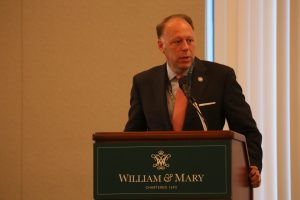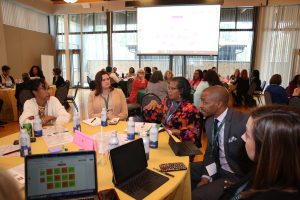Wednesday, March 29, the office of Virginia Governor Glenn Youngkin hosted a discussion forum at the College of William and Mary on mental health in the state’s education system in Sadler Tidewater. The event, titled “The Pursuit of Calm: The Mental Health Landscape of the Pandemic-Endemic Era,” hosted leaders from K-12 and postsecondary schools across Virginia. Attendees included Youngkin and First Lady of Virginia Suzanne Youngkin, Secretary of Education Aimee Rogstad Guidera and Secretary of Health and Human Resources and Board of Visitors member John E. Littel P ’22.
In December, Youngkin introduced “Right Help, Right Now,” a six-pillared approach to address Virginia’s behavioral health challenges. The three-year comprehensive plan invests more than $230 million in the state’s behavioral health system.
“Right here today, we are going to be helping him realize that plan,” College President Katherine Rowe said.
In her opening remarks, Rowe noted the importance of tackling the mental health crisis.
“Addressing mental health among children and young adults is among the most pressing challenges for educators in the U.S. and those who lead in every sector,” Rowe said.
Rowe also discussed the difficulties educators face in addressing the mental health crisis.
“The challenge of the work that we’re doing together is that it’s really pretty new,” Rowe said. “This is not work that I was trained to do when I began my career, and I imagine that’s also true for every leader here.”
Rowe commended Youngkin and other political leaders for their dedication to mental health.
“With the governor’s leadership and bipartisan support, Virginia is poised to allocate record funding for youth mental health services this year,” Rowe said.
Guidera and Littel also provided opening remarks to set the tone for the day. Guidera specifically emphasized the importance of the discussion forum in guiding future actions on mental health.
“Today is all about learning from you and catching your voices,” Guidera said. “These two issues of education and mental health are the Governor’s two priority issues. He knows that Virginia will not be the greatest place to live, work and raise a family if we do not get these two things right.”
Littel explained that the discussion forum will help inform the Governor’s office and its decision-making for future state-wide initiatives.
“We have a number of initiatives that we’re working on for this year, but we’re also trying to develop what’s in next year’s plan,” Littel said.

Littel introduced Associate Vice President for Health and Wellness and Director of Center for Mindfulness and Authentic Excellence Kelly Crace, who discussed the new challenges facing students today.
Following Crace’s discussion, Rowe introduced Youngkin for the keynote speech. During his speech, Youngkin cited Mental Health America’s state rankings, which places Virginia at 48th in the nation in youth mental health. He also tied the mental health crisis to recent instances of gun violence.
“The challenges that we have, which manifest themselves in statistical data, reflect the realities of loneliness and depression, suicidal thoughts, anxiety,” Youngkin said. “For very few, sadly, tragically, the response can turn to violence. Harming themselves, harming others. Nowhere has this been more apparent than the horrific murders in Charlottesville, Chesapeake, now tragically in Tennessee. I’d suggest that there’s no one in this room for whom this is not personal, deeply personal.”

Youngkin detailed the six pillars to his “Right Help, Right Now” plan. However, Youngkin said he first needs the Virginia General Assembly to pass the state budget.
“I need senators, delegates to come together, I need Republicans and Democrats to come together and deliver the budget,” Youngkin said. “And we will press forward with the most aggressive transformation of our behavioral health system in the entire nation. We believe we will provide that North Star that other states can be guided by.”
After his speech, Youngkin spoke with The Flat Hat about the key elements of “Right Help, Right Now,” and how its policies can improve students’ mental health.
“I believe that particularly for students, making sure we fund expansion of access is really important,” he said. “One of the more important parts of the plan is to take the telehealth part of the plan and spread it across all universities and colleges in our public schools in Virginia.”
According to Youngkin, the state is projected to run a $3.6 billion budget surplus this year. With the additional funds, Youngkin and his administration plan on expanding programs such as “Right Help, Right Now” while also cutting taxes.
“It’s an ‘and’ moment, not an ‘or’ moment, and we can accomplish both,” he said.
Youngkin also told The Flat Hat about his administration’s recent efforts to deliver his mental health initiative.
“Our Department of Behavioral Health is the primary department that will deliver a lot of the infrastructure, although it is across government,” he said. “I think a key to this is the collaborative way we work together, then bringing in systems and processes to make sure that we have accountability as well.”
According to Littel, 120 individuals at the state-level are working on implementation of the plan.
“This is not government fixing everything,” Youngkin said. “It is, in fact, the state government providing a big initial push and bring together all the stakeholders.”
During the lunch break, attendees broke out into small groups for the first roundtable session to discuss their roles and experiences with mental health in schools.

Rebekah Cohodas ’23, a wellness ambassador and student in one of Crace’s classes, attended the event. In her first roundtable, Cohodas learned from individuals with a diverse set of roles across the state.
“I talked with people who had different positions within mental health,” Cohodas said. “There was someone from K-12, someone from a two-year university and someone from a four-year university. They were really interested in and appreciated having the student at the roundtable. Some things that people might consider to be great policies look good on paper, but then if students don’t adopt it in the way it’s intended, it doesn’t actually work. And students can be wary of seeking that help.”
According to Cohodas, she left the event feeling inspired by her fellow attendees’ work in mental health across the state.
“I thought it was really inspirational to be surrounded by people who genuinely care about the mental health of our youth,” Cohodas said. “It was very inspiring and I like seeing tangible things that we could improve in the future for mental health.”
As part of the event, Youngkin and the First Lady toured the Wellness Center, which she had visited earlier this semester with Littel.
During her speech, Suzanne Youngkin discussed the opioid epidemic and substance abuse issues as roots of the mental health crisis. She highlighted the importance of Naloxone nasal sprays, which can save the life of an individual who has overdosed, and contextualized the role of the governor’s policy proposal in the broader landscape of attendees’ collective efforts to improve the landscape of mental health care in Virginia.
“Government doesn’t change lives, it just doesn’t,” Suzanne Youngkin said. “‘Right Help, Right Now’ is critically important. Putting government resources to work for the people that it’s intended to support is critically important. But you, you are the ones that change lives. So this is a thank you to you for each and every thing that you do every single day.”
In the second roundtable discussion, attendees shifted tables to meet with a new set of individuals. Following the discussion, Crace led a reflection session in which the organizers synthesized notes from both roundtables into five main categories of action areas so attendees could convey their thoughts to the Youngkin administration. The five categories were communication and sharing of information, resources, training, staffing and policy changes.
During the session, Cohodas advocated for intersectionality of implementing these policies.
“If you’re doing it without intersectionality, you’re doing a disservice to our students, particularly those in marginalized communities,” Cohodas said.
She then elaborated on the importance of promoting diversity in how educators, administrators and government officials address mental health.
“We live in a diverse time and our practices need to match the diversity of the times we live in,” Cohodas said. “We can’t have policies that actively harm the mental health of specific communities and then go ahead and say we care about mental health.”
Cohodas then reflected on her main takeaways from the event.
“In order for mental health to be a bipartisan issue, you can’t be harming the communities that struggle the most with mental health, with policies that actively pull away from their mental health, and then still say you care about mental health,” Cohodas said. “You can’t create policies that are detrimental to certain groups and then go ahead and say you care about mental health when you are not including everyone in the mental health narrative–it’s really important to consider who is missing from the narrative. Mental health is not just for white people, it’s not just for cis people–it’s for everyone.”

